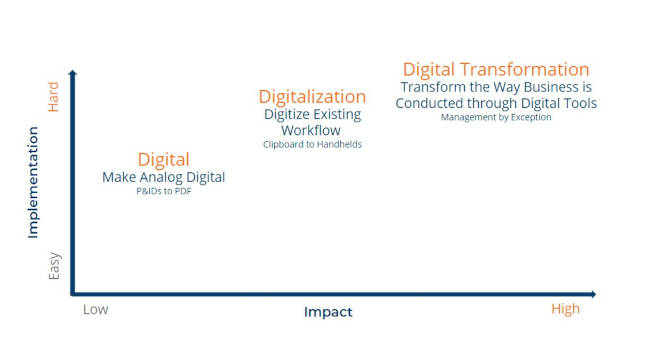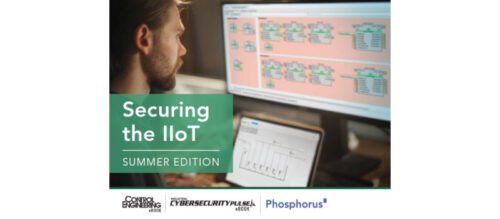Industry 4.0 assessment: Are you moving quickly enough?
While Industry 4.0 and digital transformation are often used interchangeably, they are distinctive concepts, and understanding how they differ can help organizations to implement both more effectively.
Learning Objectives
- Learn the difference between Industry 4.0 and digital transformation.
- Learn how organizational barriers that hold back digitalization can be overcome.
- Learn the steps that lead from manual processes, to digitalization and finally to full-blown digital transformation.
Industry 4.0 insights
- Industry 4.0 is about using digital platforms, products and services to gain a competitive advantage, while Digital transformation is a more substantial change that impacts the way business is conducted.
- Organizations struggle to successfully engage in digital transformation when the personnel’s mindset does not evolve alongside the technology itself.
- Already, a concept of Industry 5.0 is developing, which about developing resilient, human-centered and sustainable business strategies.
Advances in automation technology are transforming the manufacturing landscape. Broadly termed “Industry 4.0” or sometimes “digital transformation,” these smart manufacturing initiatives bring physical and cyber systems together for greater performance, efficiency, sustainability, safety and competitive advantage.
As a term, Industry 4.0 originated in 2011 — widely attributed to a German government strategy unveiled at that year’s Hannover Messe event.
Twelve years later, a lot has changed about manufacturing. In many cases, the fundamental tenets of Industry 4.0 have changed and shifted, being reprioritized, along with industry needs. For example, artificial intelligence and machine learning (AI/ML) likely play a greater part in everyone’s day to day operations than we could have dreamed about in 2011.
However, we are not adapting quickly enough in other ways and it is because of how we are looking at Industry 4.0 and what it really means.
Is it Industry 4.0 or is it digital transformation?
These two terms of often confused, but there is an important distinction between them.
Industry 4.0 is about using digital platforms, products and services to gain a competitive advantage, much like steam engines, assembly lines, and industrial robots did in previous industrial revolutions. These are new and effective tools, but the focus is not necessarily on changing the behavior of individuals using those tools.
Digital transformation is a more substantial change that impacts the way business is conducted — it is as much a shift in mindset as it is the adoption of new technologies.
Digital, digitalization and digital transformation — what’s the difference?
There can be confusion about what it really means to enact a digital transformation, and so it’s important to consider the different steps along the way. (Figure 1)

Digitalization is an intermediate step on the way to digital transformation that involves taking an existing workflow, such as walking the plant floor with a clipboard, and augments it with technology like tablets or augmented reality glasses to make it easier for engineers and inspectors to access documentation and record measurements. Courtesy: ISA
Making analog files digital and sharing them across the organization is a clear first step, and something many organizations have already started to do. In fact, many organizations began this practice even before we understood “Industry 4.0” as a concept. This is easy to implement, but relatively low impact in terms of the total digital transformation journey.
An intermediate step is digitalization. Think of an existing workflow, such as walking the plant floor with a clipboard performing inspections. If we digitalize this example, then inspectors may use tablets to update data or may even wear augmented reality tech like smart glasses. This makes it easier for engineers and inspectors to access documentation, and to record measurements, readings and observations in terms of notes, photographs and videos. All of this information can be associated with specific locations, making the processing of a report much more simplistic. But we are still walking the floor. We are still logging data. We are still creating a report. The engineer’s job is not too different than it was before.
The final step is true digital transformation — where digital tools fundamentally change and even improve the way the organization does its business. An ISA board member recently told a story about how an oil and gas operator was beginning to rely upon ML to identify corrosion on their offshore production platforms through image analysis. An ML engine uses imagery captured throughout the facility for engineering and operations purposes to identify potential areas of corrosion, reducing the need for conventional manual inspection with its potentially biased analysis.
In this scenario, the ML algorithm also may identify potential issues that might otherwise be missed in a large-scale manual effort. When that team of inspectors and engineers no longer has to manually walk the whole facility, time and effort are freed up to manage the most effective ways to troubleshoot and solve the problems initially identified by the machines.
People and culture
Digital transformation is not a project. It is a journey.
And while I have had the pleasure to work alongside many dedicated and passionate engineers, it is also not something one person can will into reality.
This journey involves so much more than just implementing new technology. It involves the people and culture of an organization, as well as its existing and planned business capabilities. And of course, there are always regulatory and compliance considerations at play.
Earlier this year, the ISA hosted a webinar about Industry 4.0 and digital transformation to understand what people know and what knowledge gaps they have. The vast majority of our attendees had at least some concerns, or faced challenges internally.
International Society of Automation poll on Industry 4.0, digital transformation
42% of respondents said, “We don’t know where to start — it’s overwhelming.” Other concerns centered around the cost, lack of clarity around who is in charge of the project and whether return on investment (ROI) was demonstrable.
However, 15% of respondents said, “No obstacles here, we are excited!” That’s great news, and that type of response will become more common as digital transformation becomes more prevalent in industrial and manufacturing sectors.
If companies are facing resistance, they should seek additional training and resources to help present a case to management. There are many groups supporting professional engineers that can help demystify Industry 4.0 and digital transformation and address common objections.

A 2023 ISA webinar poll broke down the attitudes held by respondents toward Industry 4.0 and digital transformation. Courtesy: ISA
Don’t forget about cybersecurity
智能制造技术是implemented and mature, new and increased cybersecurity challenges have emerged beyond device-level IT risks. Termed operational technology (OT) cybersecurity, this field refers to the security and safety of industrial environments, and it is of critical importance when it comes to securing infrastructure, supply chains and more.
One of the biggest challenges facing the OT cybersecurity space is legacy equipment found in much of the global critical infrastructure. OT-specific security equipment and platforms are becoming more prevalent in the market to address this challenge, but not all of these are created equal nor are they uniformly adopted.
In 2023 and 2024, we expect government stakeholders and industry asset owners will demand rigorous solutions that present the highest levels of security and interoperability and will look for compliance with recognized international standards like ISA/IEC 62443. Workforce development will be another key area of focus, and plant managers will be even more focused on OT cybersecurity training and certification programs in the years ahead.
Digitalization enabled by the industrial Internet of Things (IIoT) has increased during the past decade with advances in sensor technology offering ever more context about equipment, processes and operations. New applications and advancements could also mean greater vulnerability, which is why a risk management and mitigation strategy is a critical part of digital transformation.
Are we too late?
Industry 4.0 is not a destination; it is an ongoing journey. Manufacturers who can best optimize their cyber-physical systems (CPSs) with their workforce will be the winners in their market. Our advice is to do what you can today. Then wake up and do what you can tomorrow. It is never too late to get started.
有一个行业5.0?
There is already buzz about the concept of Industry 5.0, which aims to articulate the role and contribution that industry makes to society as a whole. Where Industry 4.0 is about improvements to safety, process, efficiency and profitability, Industry 5.0 is about resilient, human-centered and sustainable business strategies.
像工业4.0,这些想法可能的事情organizations are already doing. For example, many corporations have pledged their commitment to sustainability and environmental practices, with some making further commitments toward science-based targets. Like Industry 4.0, the meaningful changes needed to transform a business require mindset shifts. As an association of professionals, ISA focuses on how people can make the world a better place. Perhaps instead of a digital transformation we will call this a human transformation. Regardless, Industry 5.0 does loom large as the next strategic direction for industry and government initiatives.
Claire Fallonis executive director at the International Society of Automation (ISA), a CFE Media and Technology content partner. Edited by David Miller, content manager,Control Engineering, CFE Media and Technology,dmiller@cfemedia.com.
MORE ANSWERS
Keywords: Industry 4.0, Digital Transformation
CONSIDER THIS
How can youchange the mindset of your workforce to better enable succesful digital transformation?
Do you have experience and expertise with the topics mentioned in this content? You should consider contributing to our CFE Media editorial team and getting the recognition you and your company deserve. Clickhereto start this process.







